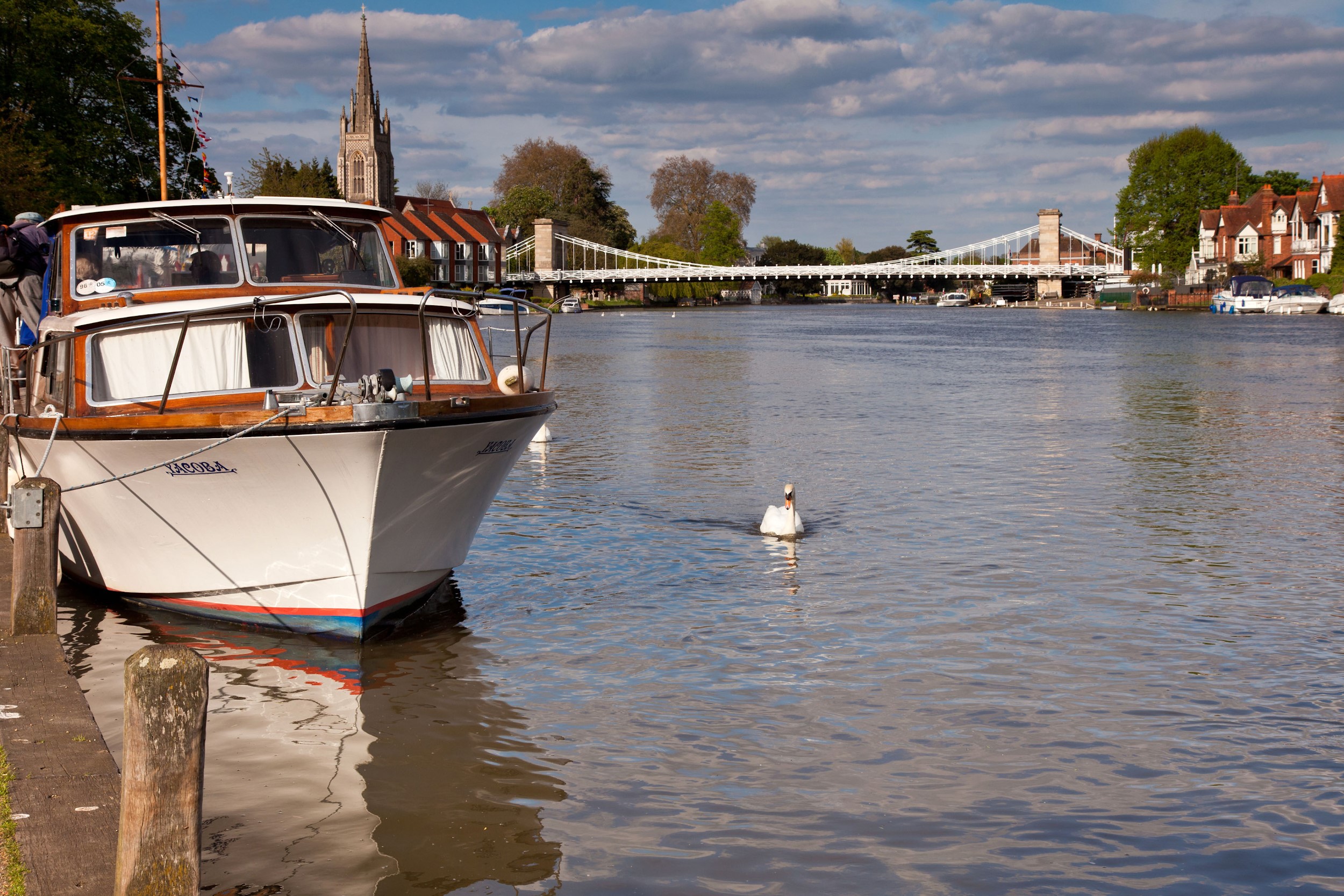South Chilterns Partnership
- Catchment HostThames 21, Chiltern Chalk Streams Project, Action for the River Kennet
- River Basin DistrictThames
- Management CatchmentThames and Chilterns South
- Management Catchment ID3098
Catchment partnership vision
A healthy and sustainable water environment throughout the South Chilterns catchment area in which all significant water bodies achieve and maintain Good Ecological Status, and:
- the waterscapes and heritage assets of the catchment, the iconic River Thames in particular, are protected, enhanced and valued by all
- people of all ages value and enjoy the water environment and participate actively in its management
- our globally rare chalk streams are naturalised and sustainable
- wildlife thrives throughout the catchment
- river flows throughout the catchment are managed sustainably
- surface waters are of good quality, supporting rich and sustainable ecological diversity throughout the catchment.

Chilterns Conservation Board
Related websites
Find out more about the activities and ambitions of this catchment partnership and how you can get involved to help improve the water environment in the catchment.
Catchment challenges
Current challenges identified by partnership

Physical modifications
Modifications for milling, navigation, flood alleviation, urban development etc. have degraded and disconnected habitats

Pollution from agriculture and rural areas
Nutrients and pesticides contaminating groundwater and sediment entering rivers is degrading habitat and changing ecology

Pollution from waste water
Pollution from combined sewer overflows and groundwater infiltration severely impacting chalk stream health
Wider water environment challenges identified by partnership
Nature Recovery, protect and enhance rare habitats including chalk streams
As a partnership we recognise the value of chalk streams and work to protect and enhance these rare habitats
Reduce storm overflows and drainage system incidents
A total of 652 spills from storm overflows took place in the catchment in 2021
Connecting communities with nature
The importance of connecting the urban community with nature has benefits for both the environment and human well-being
Nature Recovery, designated areas for nature and biodiversity
Through multi-benefit projects we aim to help aid nature recovery in the catchment
Build environmental resilience and adaptation to climate change
We are working with landowners to adapt to climate change, from changes in land management, to reconnecting rivers with their floodplain
Support Nature Recovery Network and Local Nature Recovery Strategy
Aligning our goals as a partnership with these larger networks and strategies will help provide multiple benefits to projects
Future challenges predicted by partnership

Pollution from agriculture and rural areas
Intensively farmed catchment leading to large scale diffuse pollution and sediment run off

Pollution from waste water
The catchment suffers from a high number of spills annually, which is likely to increase with climate change

Changes to the natural flow and water levels
Due to a heavily farmed catchment, abstraction is an ongoing issue, likely to become more worsen with the effects of climate change
Future challenges predicted by Environment Agency
Future challenges in 2050
- Invasive Non-native Species
- Pollution from waste water
- Changes to the Natural Flow and Water Levels
Emerging challenges
- Pollution from waste water
- Changes to the Natural Flow and Water Levels
- Pollution from Agriculture and Rural Areas
Partnership success highlights 2016 to 2021
Some key successes from 2016-2021:
- Pang Valley Flood Forum, a pilot Defra Natural Flood Management project.
- Revive the Wye (RTW): formed in 2007, this local community initiative conserves and protects the Wye and raises awareness of its importance. Since 2016, RTW partners have restored and enhanced over 4km of urban chalk stream, engaging over 500 local community volunteers to progress this work. Projects have included enhancing habitat at five sites, funded through the Catchment Partnership Action Fund, Rivers & Wetlands Community Days Fund, Thames Water, Wycombe District Council and the Chilterns Chalk Streams Project (CCSP). River restoration projects have been completed at Desborough and the Rye Recreation Grounds by Wycombe District Council, with support from RTW partners. Additional work has included eradicating Himalayan Balsam from the top 5km of the Wye, establishing a Riverfly monitoring group on the river and introducing Trout in the Classroom at two schools in the catchment by the CCSP.
- Collaborative working on the WINEP Sulham Brook project.
- Joining up sectors and activity regarding flood, environment and wellbeing.
- Thames Catchment Community Eel project engaged citizen scientists to map barriers to eel migration and funded feasibility studies for the priority barriers.

Chiltern Chalk Streams Project
Partnership development plans
More active projects and more partnership members. We'd like to see an engaged team of citizen scientists. Increasing the number of members and interests represented. More promotion of the Catchment Partnership across the region, more work with parish councils and local residents, more citizen science, more educational work. We are working on more shared projects where we work together to produce multi-benefit projects and tap into wider and multiple funding sources. People within the SCCP took part in the EA Citizen Jury and we would like to see that output included in future plans and activities.
Partnership priority actions and measures for 2022 to 2027
Confident
Pang to Good: Tidmarsh wetland creation 2020-2024, to increase habitat diversity and slow the flow of water in floods
- Reason for measure
- Control or manage regulated flows
- Delivery mechanism
- Other local funding
- Location
- Pang
Confident
Mills of the Wye Project: Chalk Cherries & Chairs, fish passage and habitat enhancement on the urban Chalk Stream
- Reason for measure
- Manage modified habitats
- Delivery mechanism
- Heritage Lottery Fund
- Location
- Wye (High Wycombe fire station to Thames)
Confident
Chiltern Chalk stream project: River restoration and Education & Engagement Programmes 2021- 2025
- Reason for measure
- Manage modified habitats
- Delivery mechanism
- Other local funding
- Location
- Wye (High Wycombe fire station to Thames) Wye (Source to High Wycombe fire station) Hughenden Stream
Confident
Revive the Wye and Chiltern Chalk Streams Project - Wye Interpretation Project - 2021-22
- Reason for measure
- Manage modified habitats
- Delivery mechanism
- Other local funding
- Location
- Wye (High Wycombe fire station to Thames) Wye (Source to High Wycombe fire station) Hughenden Stream
Confident
Benson Nature Group & Chiltern Chalk Streams Project: Ewelme Brook Community Project 2021-2025 working with communities
- Reason for measure
- Mitigate the impacts on ecology from physical modifications in modified waters
- Delivery mechanism
- Other local funding
- Location
- Ewelme Stream (Source to Thames)
Confident
Fish passage at Riversdale weir on the River Wye
- Reason for measure
- Manage modified habitats
- Delivery mechanism
- Other local funding
- Location
- Wye (High Wycombe fire station to Thames) Wye (Source to High Wycombe fire station)
Less certain
CCSP/National Trust - Restoration of the Hughenden Stream at Hughenden Manor 2022-23
- Reason for measure
- Mitigate the impacts on ecology from physical modifications in modified waters
- Delivery mechanism
- Heritage Lottery Fund
- Barriers to delivery
- Identify and secure funding
- Location
- Hughenden Stream
Less certain
Wild and Wonderful Wetlands: a network of wetland sites providing space for wildlife and climate change resilience
- Reason for measure
- Control or manage rural diffuse pollution
- Delivery mechanism
- WEIF Water Environment Improvement Fund
- Barriers to delivery
- Identify and secure funding
- Location
- Chilterns South
Less certain
Healthy Habitats: habitat restoration projects progressing biodiversity delivery across our catchment
- Reason for measure
- Mitigate the impacts on ecology from physical modifications in modified waters
- Delivery mechanism
- Environment Land Management Scheme (future full-scale roll-out)
- Barriers to delivery
- Funding required from land based schemes such as ELM
- Location
- Chilterns South
Less certain
Citizen Science Programme: empowering citizens by making them part of decision-making about their local environment
- Reason for measure
- Control or manage point source discharges
- Delivery mechanism
- Other philanthropic/charitable/trust funds
- Barriers to delivery
- Funding for a Project Officer to develop and deliver projects
- Location
- Chilterns South
Less certain
Tackling INNS, develop a catchment wide plan to control the spread of Invasive Non-Native Species
- Reason for measure
- Control or manage invasive non-native species
- Delivery mechanism
- Potential future water industry programme
- Barriers to delivery
- Identify and secure funding
- Location
- Chilterns South
Less certain
Hamble Brook Chalk Stream Restoration Project
- Reason for measure
- Control or manage rural diffuse pollution
- Delivery mechanism
- WEIF Water Environment Improvement Fund
- Barriers to delivery
- Funding and collaborative working is required
- Location
- Hamble Brook
Wider water environment
River Pang Flagship Chalk Stream Project
- Reason for measure
- Nature Recovery, protect and enhance rare habitats including chalk streams
- Delivery mechanism
- Confirmed water industry national environment programme 2020-2025
- Location
- Pang
Catchment Partnership contributors
Partners involved in the creation of this page and the actions of the partnership:
- North Wessex Downs AONB
- UK Centre for Ecology & Hydrology (CEH)
- Little Marlow Lakes and Countryside Park
- West Berkshire Countryside Society
- Berks, Bucks and Oxon Wildlife Trust (BBOWT)
- Action for the River Kennet
- Environment Agency
- Chilterns Chalk Streams Project
- Chilterns AONB
- Revive The Wye Partnership
- Withymead Nature Reserve
- Forestry Commission
- Natural England
- Kennet Valley Fisheries Association
- Chiltern Rangers CIC
- South Oxfordshire District Council
- Buckinghamshire Council
- Pang Valley Flood Forum
- Reading University
- British Canoeing